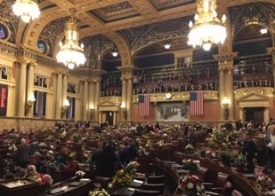Subscribe for Weekly Updates

Pennsylvania's Local Tax Structure and the Imperative Need for Reform
 By David A. Caplan, CPA
By David A. Caplan, CPA
Doing a Pennsylvania local tax return is one of my favorite things as a sole practitioner. Of course I’m joking! My feeling is exactly the opposite, and I imagine most tax practitioners in the state feel the same way I do. Pennsylvania's local tax structure has long been a topic of consternation due to its relative uniqueness and intricacies.
With a complex system covering various taxes at the local level, the state faces challenges when it comes to fairness, efficiency, and economic growth. This blog emphasizes the urgent need for reform of Pennsylvania’s local tax structure to ensure a more equitable and sustainable system.
Pennsylvania's local tax structure is a patchwork of different taxes imposed at county and municipal levels. There are 67 counties, 500 school districts, 56 cities, 956 boroughs, 93 first-class townships and 1,454 second-class townships. The types of tax include property, earned income, local sales, business privilege, and more. The system's complexity and inconsistencies have resulted in several issues that hinder economic development and burden taxpayers.
 The PICPA’s Local Tax Thought Leadership Committee, of which I am the chair, has been working on reforming the system for quite some time. In fact, the PICPA played a vital role in the passage and enactment of Act 32 of 2008, which materially improved the local tax collection system. It certainly wasn’t a perfect piece of legislation, but it did put into law some meaningful changes and added much-needed simplification and efficiency to the process. We followed up Act 32 with Act 42 of 2014 (Base of Operation) and then Act 18 of 2018 (Technical Corrections to Act 32). For Act 18, we had to overcome a veto by then Gov. Tom Wolf, but the legislation ultimately became law.
The PICPA’s Local Tax Thought Leadership Committee, of which I am the chair, has been working on reforming the system for quite some time. In fact, the PICPA played a vital role in the passage and enactment of Act 32 of 2008, which materially improved the local tax collection system. It certainly wasn’t a perfect piece of legislation, but it did put into law some meaningful changes and added much-needed simplification and efficiency to the process. We followed up Act 32 with Act 42 of 2014 (Base of Operation) and then Act 18 of 2018 (Technical Corrections to Act 32). For Act 18, we had to overcome a veto by then Gov. Tom Wolf, but the legislation ultimately became law.
Our next phase of local tax reform involves two steps, one administrative and the other legislative. The first step involves working with the tax collector community to facilitate a statewide local electronic filing system that would piggyback on the federal Modernized e-File (MeF) system. A model we can look to for guidance is Ohio’s Regional Income Tax Agency (RITA). RITA provides services to collect income tax for municipalities in Ohio, and its board of trustees is authorized to administer and enforce the income tax laws of each of the participating municipalities. However, each municipal corporation retains its right to administer and enforce its own income tax laws concurrently with the board.
The second track in this effort covers legislative changes. I’m going to stick my neck out for a moment. What I gathered below represents a robust plan to modernize and reform Pennsylvania’s local taxing system, but not everyone will like or agree with all the ideas proposed here. Note that most items do not apply to Philadelphia:
- Elimination of business privilege, local services, per capita, and occupation taxes.
- Addition of a statewide employer local earned income tax (EIT).
- Elimination of rate caps on EIT.
- Elimination of the Philadelphia “super credit” by only allowing a credit on double taxation of specific income.
- Possible lowering of real estate tax.
You may not agree with everything set down above, but make no mistake – Pennsylvania's local tax structure is in dire need of reform to address its many shortcomings and to promote fairness and efficiency while allowing for economic growth. By streamlining the process and improving the administration of the system, Pennsylvania can create a local tax system that benefits all residents and fosters a thriving economy.
The time is ripe for policymakers to come together, engage stakeholders, and enact comprehensive reforms that will shape a brighter future for the state's local tax structure. As we move into the fall, the Local Tax Thought Leadership Committee will be working with various stakeholders, including our state lawmakers and tax collectors, on identifying specific changes that will need legislation to effectuate. The committee is also preparing an issue brief that will define the scope of this issue and layout tangible solutions. In the end, however, no changes are possible without our members stepping forward and working with the PICPA to keep pushing forward to see improvements to our local tax collection system.
The PICPA stands ready to work with all stakeholders to improve our local taxing structure.
David A. Caplan, CPA, is a sole practitioner in Lafayette Hill, Pa., and is the 2023-2024 chair of PICPA’s Local Tax Thought Leadership Committee. He can be reached at dactyl@caplancpa.com.
Sign up for PICPA's weekly professional and technical updates by completing this form.
Statements of fact and opinion are the authors’ responsibility alone and do not imply an opinion on the part of the PICPA's officers or members. The information contained herein does not constitute accounting, legal, or professional advice. For actionable advice, you must engage or consult with a qualified professional.







Leave a commentOrder by
Newest on top Oldest on top